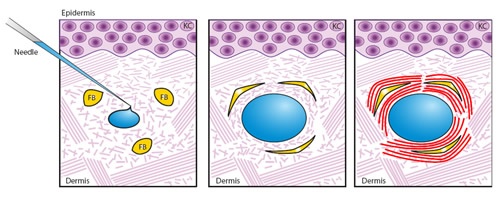The current battle between the makers of anti-wrinkle products – widely compared with the Coke and Pepsi struggle for superiority – is receiving an injection of scientific understanding with the release of a new study from the University of Michigan Health System.
The study is the first to discover that one of the fillers – known by the brand-name Restylane – works by stretching fibroblasts, the cells in the skin that make collagen, in a way that causes the skin to create new collagen. This new, natural collagen then would contribute to the reduction of the appearance of creases and wrinkles. The study also shows that the product seems to inhibit the breakdown of existing collagen.

“Prior to our research, it has been thought that Restylane’s physical volume caused the improvement in the appearance of one’s skin,” says senior author John J. Voorhees, M.D., the Duncan and Ella Poth Distinguished Professor and chair of the Department of Dermatology at the U-M Medical School.
“It is true that the physical presence of the product increases volume in the skin. Our research makes clear that injection of the product leads to creation of new collagen, which contributes to reduction in creases and wrinkles in a person’s aging skin,” Voorhees says.
The paper appears in the new issue of the journal Archives of Dermatology. Funding was provided by the U-M Department of Dermatology Cosmetic Research Fund, the Babcock Research Endowment at U-M and grants from the National Institutes of Health.
While Medicis Aesthetics provided the Restylane syringes used in the study, the company (which makes Restylane) had no involvement in the collection, management, analysis and interpretation of the data. The company also was not involved in the preparation or review of the manuscript.
Restylane has been in the news frequently in recent months, in part because of a competition between Medicis and Allergan Inc., the maker of the dermal filler Juvederm. More than one observer has compared the rivalry to the height of the “cola wars” between Coke and Pepsi. These fillers are used to reduce the appearance of creases and wrinkles on the lower part of the face.
The findings of the study are based on injections in 11 volunteers, ages 64 to 84 years, and the subsequent analyses of the skin biopsies (including immunostaining and gene expression).
Some of the key findings relate to fibroblasts, which are in the dermis, the layer of the skin below the epidermis (outer layer). In young people, fibroblasts are stretched, and this produces enough collagen to make the skin appear relatively smooth. As people age, the fibroblasts become relaxed and do not stretch as easily, and therefore do not release as much collagen, causing creases and wrinkles to appear.
With the injection of Restylane in this study, the relaxed fibroblasts were re-stretched, says lead author Frank Wang, M.D., research fellow with the U-M Department of Dermatology. In a sense, this stretching encourages the fibroblasts to behave in the way they do in younger skin and to release collagen.
Another factor is that in older skin, an enzyme called collagenase breaks down the collagen in the skin. The research found that injection of this dermal filler inhibits the breakdown of collagen by collagenase, which also helps with the appearance of one’s skin, Wang says.
The study notes that procedures involving dermal fillers are increasingly common. Of the 12 million cosmetic procedures performed annually in the United States, about 1 million currently involve the class of injectable fillers that includes Restylane, according to the researchers.
This article was written from a news release issued by University of Michigan Health System





Comments